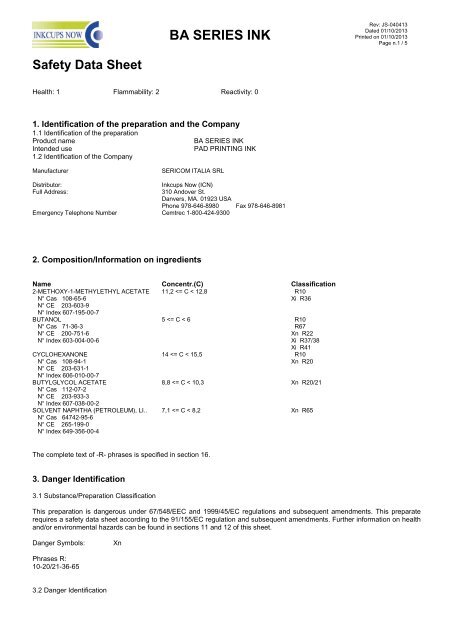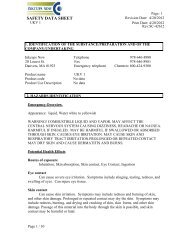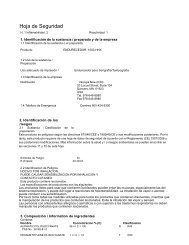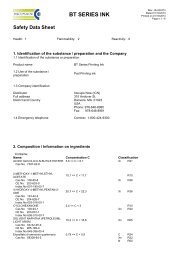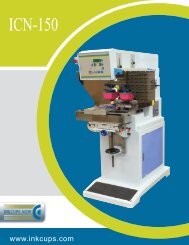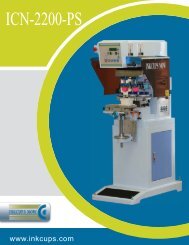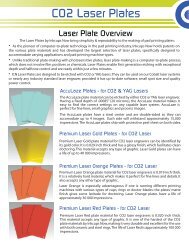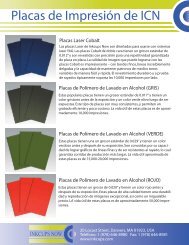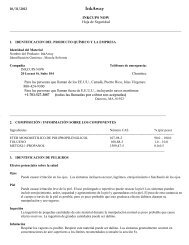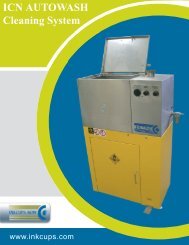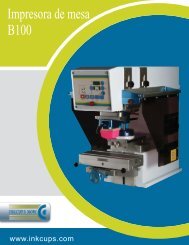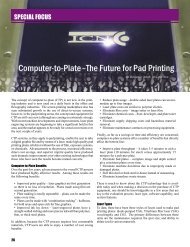BA series MSDS - Inkcups Now
BA series MSDS - Inkcups Now
BA series MSDS - Inkcups Now
Create successful ePaper yourself
Turn your PDF publications into a flip-book with our unique Google optimized e-Paper software.
<strong>BA</strong> SERIES INK<br />
Rev: JS-040413<br />
Dated 01/10/2013<br />
Printed on 01/10/2013<br />
Page n.1 / 5<br />
Safety Data Sheet<br />
Health: 1 Flammability: 2 Reactivity: 0<br />
1. Identification of the preparation and the Company<br />
1.1 Identification of the preparation<br />
Product name<br />
Intended use<br />
1.2 Identification of the Company<br />
<strong>BA</strong> SERIES INK<br />
PAD PRINTING INK<br />
Manufacturer<br />
SERICOM ITALIA SRL<br />
Distributor:<br />
<strong>Inkcups</strong> <strong>Now</strong> (ICN)<br />
Full Address:<br />
310 Andover St.<br />
Danvers, MA. 01923 USA<br />
Phone 978-646-8980 Fax 978-646-8981<br />
Emergency Telephone Number Cemtrec 1-800-424-9300<br />
2. Composition/Information on ingredients<br />
Name Concentr.(C) Classification<br />
2-METHOXY-1-METHYLETHYL ACETATE 11,2
<strong>BA</strong> SERIES INK<br />
Rev: JS-040413<br />
Dated 01/10/2013<br />
Printed on 01/10/2013<br />
Page n.2 / 5<br />
Because of its chemical-physical features, this product is graded as combustable (flash-point 38 °C or higher and 55 °C or<br />
lower ).<br />
HARMFUL BY INHALATION AND IN CONTACT WITH SKIN.<br />
IRRITATING TO EYES.<br />
HARMFUL: MAY CAUSE LUNG DAMAGE IF SWALLOWED.<br />
4. First-aid measures<br />
EYES: Irrigate copiously with clean, fresh water for at least 15 minutes. Seek medical advice.<br />
SKIN: Wash immediately with plenty of water. Remove contaminated clothing. If irritation persists seek medical attention. Wash<br />
contaminated clothing before using them.<br />
INHALATION: Remove to fresh air. If breathing is irregular seek medical advice.<br />
INGESTION: Obtain immediate medical attention. Induce vomiting only if indicated by the doctor. Never give anything by mouth<br />
to an unconscious person.<br />
5. Fire-fighting measures<br />
Closed containers exposed to the heat of a fire may lead to pressure rise and explode. For information on environmental and<br />
health risks, protection of the respiratory airways, ventilation and individual protective measures refer to the other sections of<br />
this sheet.<br />
Extinguishing measures: CO2, foam, AFFF, chemical powder for flammable liquids. Water may not be effective to extinguish the<br />
fire, nevertheless it should be used to cool the containers exposed to flames and prevent fires and explosions. For leakage and<br />
spillage that have not caught fire, nebulized water may be used to disperse the flammable vapours and protect the people<br />
involved in stopping the leakage.<br />
Equipment: wear equipment complete with helmet and face shield and protection of the neck, selfbreathing apparatus at<br />
pressure or demand, insulative jacket and trousers, with bands around the arms, legs and waist.<br />
6. Accidental release measures<br />
Extinguish the sources of ignition or heat; cover the spillage with inert absorbent material. Collect as far as possible the resulting<br />
mass and discard the remainder by spraying water, if not contraindicated.<br />
For information on environmental and health risks, protection of the respiratory airways, ventilation and individual protective<br />
measures refer to the other sections of this sheet.<br />
7. Handling and storage<br />
Store in a wellventilated place keeping the containers closed when not used. Do not smoke while handling. Keep far away from<br />
sources of heat, naked flames and sparks and other sources of ignition; do not spray in the vicinity of flames or incandescent<br />
materials.<br />
For information on environmental and health risks, protection of the respiratory airways, ventilation and individual protective<br />
measures refer to the other sections of this sheet.<br />
8. Exposure controls/personal protection.<br />
2-METHOXY-1-METHYLETHYL ACETATE<br />
- TLV TWA 270 mg/m3 MAK<br />
BUTANOL<br />
- TLV TWA 150 mg/m3 NIOSH<br />
- TLV CEILING 152 mg/m3 ACGIH<br />
CYCLOHEXANONE<br />
- TLV TWA 100 mg/m3 ACGIH<br />
BUTYLGLYCOL ACETATE<br />
- TLV TWA 33 mg/m3 NIOSH94<br />
TLV of solvent mixture: 139 mg/mc<br />
In order to minimize exposure as far as possible, it is strongly recommended to use adequate individual protective measures<br />
such as: masks suitable for the product, goggles, gloves and overalls. Do not eat, drink or smoke while handling it. Accurately<br />
wash the hands with soap and water before meals and at the end of the work shift.
<strong>BA</strong> SERIES INK<br />
Rev: JS-040413<br />
Dated 01/10/2013<br />
Printed on 01/10/2013<br />
Page n.3 / 5<br />
9. Physical and chemical properties<br />
Colour<br />
various<br />
Odour<br />
characteristic<br />
State<br />
paste<br />
Solubility<br />
N.A.<br />
Water solubility<br />
none<br />
Viscosity<br />
N.A.<br />
Vapour density<br />
N.A.<br />
Evaporation speed<br />
N.A.<br />
Comburent properties<br />
N.A.<br />
Partition coefficient: n-octanol/water<br />
N.A.<br />
pH<br />
N.A.<br />
Boiling point 145°C<br />
Flash point<br />
> >38 C<br />
Explosive properties<br />
N.A.<br />
Vapour pressure<br />
N.A.<br />
Molecular weight 1<br />
Specific gravity<br />
1,200Kg/l<br />
10. Stability and reactivity<br />
The product is stable in normal conditions of use and storage. When heated or in the event of a fire, carbonoxides may be<br />
released and vapours which are dangerous to health. The vapours may also form explosive mixtures with the air.<br />
1-methoxy-2-propylacetate: it is stable but in presence of air, it can gradually form peroxides which explode due to the rise in<br />
temperature. It can react violently with oxidizing agents and strong acids and alkaline metals. Avoid copper, aluminium and their<br />
alloys when storing. Store under inert atmosphere, repaired from humidity because it easily hydrolyses.<br />
Butyl alcohol is biodegradable (MITI1984). The mixture reacts with strong oxidizing agents and with alkaline metals releasing<br />
flammable hydrogen. It attacks different types of plastic materials.<br />
Cyclohexanone reacts violently with strong oxidizing agents and attacks different types of plastic materials (ref. H.C.S.)<br />
11. Toxicological information<br />
Acute effects: inhalation or cutaneous absorption of this product are harmful. This product may irritate mucosas, the upper<br />
respiratory tract, and eyes. Exposure symptoms may include: stinging and irritated eyes, mouth, nose, throat; cough, respiratory<br />
disorders, dizziness, headache, nausea and sickness.<br />
In the most serious cases, inhalation of this product may cause larynx and bronchial tube edema and irritation, chemical<br />
pneumonia and pulmonary edema. Upon contact with skin, this product may irritate it, causing an increase in skin temperature,<br />
swelling and itchiness. Ingestion of even small amounts of this product may cause health problems (stomach pain, nausea,<br />
sickness, diarrhoea, etc.).<br />
The introduction of even small quantities of this liquid into the respiratory system during ingestion or vomit may cause<br />
bronchopneumonia and pulmonary edema.<br />
1-methoxy-2-propanol and corresponding acetate: the main route of entry is the skin, whereas the respiratory route is less<br />
important owing to the low vapour tension of the product. Concentrations above 100 ppm cause irritation of the eyes, nose and<br />
oropharnyx.<br />
The recommended limit of exposure is 100 ppm for 8 hours. At 1000 ppm disturbance in the equilibrium and severe irritation of<br />
the eyes is observed. (For further details refer to INRS, Fiche toxicologique, nr. 221).<br />
Clinical and biological examinations carried out on exposed volunteers revealed no anomalies. Acetate produces greater skin<br />
and ocular irritation on direct contact. No chronic effects have been reported in man. In vitro genotoxicity tests on animals<br />
resulted to be negative.<br />
No significant effects were observed in studies on animal reproduction.<br />
The following experimental data confirm that the substance is not even harmful: oral LD50 in the rat = 7900 mg/kg, inhalation<br />
CL50 in the rat 4 hours = 55.2 mg/l (Fiche toxicologique nr. 221).<br />
12. Ecological information<br />
Use this product according to good working practices. Avoid litter. Inform the competent authorities, should the product reach<br />
waterways or sewers or contaminate soil or vegetation.
<strong>BA</strong> SERIES INK<br />
Rev: JS-040413<br />
Dated 01/10/2013<br />
Printed on 01/10/2013<br />
Page n.4 / 5<br />
13. Disposal considerations<br />
Consider the possibility of burning the product in a suitable inceneritor. Acid or basic products must always be neutralized<br />
before undergoing any treatment, including biological treatment whenever feasible. If the waste is solid, it can be disposed of in<br />
a landfill.<br />
14. Transport informations<br />
These goods must be transported by vehicles authorized to the carriage of dangerous goods according to the provisions set out<br />
in the current edition of the Code of International Carriage of Dangerous Goods by Road (ADR) and in all the applicable national<br />
regulations. These goods must be packed in their original packings or in packings made of materials resistant to their content<br />
and not reacting dangerously with it. People loading and unloading dangerous goods must be trained on all the risks deriving<br />
from these substances and on all actions that must be taken in case of emergency situations.<br />
Road and rail transport:<br />
ADR: 3,III UN:1210<br />
Label: 3<br />
Proper Shipping Name:<br />
Printing ink<br />
Carriage by sea (shipping):<br />
IMO class: 3 UN:1210<br />
Packing Group:<br />
III<br />
EMS: 3-05<br />
Proper Shipping Name:<br />
Printing ink<br />
Transport by air:<br />
IATA: 3 UN:1210<br />
Packing Group:<br />
III<br />
Label: 3<br />
Cargo:<br />
Packaging instructions: 310 Maximum quantity: 220 L<br />
Pass.:<br />
Packaging instructions: 309 Maximum quantity: 60 L<br />
Special Instructions:<br />
A72<br />
15. Regulatory information<br />
Health hazard symbol<br />
Xn<br />
HARMFUL<br />
- R10 FLAMMABLE.<br />
- R20/21 HARMFUL BY INHALATION AND IN CONTACT WITH SKIN.<br />
- R36 IRRITATING TO EYES.<br />
- R65 HARMFUL: MAY CAUSE LUNG DAMAGE IF SWALLOWED.<br />
- S 9 KEEP CONTAINER IN A WELL-VENTILATED PLACE.<br />
- S13 KEEP AWAY FROM FOOD, DRINK AND ANIMAL FEEDINGSTUFFS.<br />
- S26 IN CASE OF CONTACT WITH EYES, RINSE IMMEDIATELY WITH PLENTY OF WATER AND SEEK<br />
MEDICAL ADVICE.<br />
- S36 WEAR SUITABLE PROTECTIVE CLOTHING.<br />
- S62 IF SWALLOWED, DO NOT INDUCE VOMITING: SEEK MEDICAL ADVICE IMMEDIATELY AND SHOW THIS<br />
CONTAINER OR LABEL.<br />
Danger labelling under regulations 67/548/CEE and 1999/45/CE and following amendments and adjustments.
<strong>BA</strong> SERIES INK<br />
Rev: JS-040413<br />
Dated 01/10/2013<br />
Printed on 01/10/2013<br />
Page n.5 / 5<br />
Workers exposed to this chemical agent must undergo health checks according to regulation 98/24/CE.<br />
16. Further information<br />
Text of -R- phrases quoted in section 2 of the sheet.<br />
- R10 FLAMMABLE.<br />
- R20 HARMFUL BY INHALATION.<br />
- R20/21 HARMFUL BY INHALATION AND IN CONTACT WITH SKIN.<br />
- R22 HARMFUL IF SWALLOWED.<br />
- R36 IRRITATING TO EYES.<br />
- R37/38 IRRITATING TO RESPIRATORY SYSTEM AND SKIN.<br />
- R41 RISK OF SERIOUS DAMAGE TO EYES.<br />
- R65 HARMFUL: MAY CAUSE LUNG DAMAGE IF SWALLOWED.<br />
- R67 VAPOURS MAY CAUSE DROWSINESS AND DIZZINESS.<br />
THIS PRODUCT IS SUITABLE FOR PROFESSIONAL USE ONLY.<br />
GENERAL BIBLIOGRAPHY<br />
1. Regulation 1999/45/CE and following amendments;<br />
2. Regulation 67/548/CEE and following amendments and adjustments (technical adjustment XXVIII);<br />
3. Regulation 91/155/CEE and following amendments;<br />
4. The Merck Index. - 10th Edition;<br />
5. Handling Chemical Safety;<br />
6. Niosh - Registry of Toxic Effects of Chemical Substances;<br />
7. INRS - Fiche Toxicologique (toxicological sheet);<br />
8. Patty - Industrial Hygiene and Toxicology;<br />
9. N.I. Sax-Dangerous properties of Industrial Materials-7, 1989 Edition;<br />
Note for users:<br />
The information contained in the present sheet are based on our own knowledge on the date of the last version. Users must<br />
verify the suitability and thoroughness of provided information according to each specific use of the product .<br />
This document must not de regarded as a guarantee on any specific product property.<br />
The use of this product is not subject to our direct control; therefore, users must, under their own responsibility, comply with the<br />
current health and safety laws and regulations. The producer is relieved from any liability arising from imporoper uses.<br />
Changes to previous review<br />
The following sections were modified:<br />
06 / 01 / 2007


